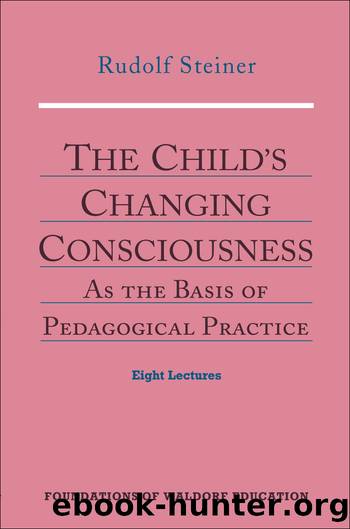The Childâs Changing Consciousness by Rudolf Steiner

Author:Rudolf Steiner
Language: eng
Format: epub
Tags: EDU040000
Publisher: Anthroposophic Press
Published: 1996-01-06T00:00:00+00:00
A question is asked regarding music lessons given to a seventeen-year-old girl.
RUDOLF STEINER: The essential thing is what Mister Baumann has already presented to us.1 With the beginning of puberty and during the following years, a certain musical judgment takes the place of a previous feeling for music and of a general musical experience. The faculty of forming musical judgments emerges. This becomes very noticeable through the phenomenon characterized by Mister Baumannâthat is, a certain self-observation begins to manifest, a self-observation of the studentâs own singing and, with it, the possibility of using the voice more consciously, and so on. This has to be cultivated methodically.
At the same time, however, something else becomes noticeableâthat is, from this stage on, natural musical memory begins to weaken a little, with the effect that students have to make more effort to remember music. This is something that has to be especially remembered during music lessons. Whereas, before puberty the childrenâs relationship to music was spontaneous and natural, and because of this their musical memory was excellent, some of them now begin to encounter difficultiesânot in taking in music, but in remembering it. This needs to be addressed. One must try to go over the same music several times, not by immediate repetition, but intermittently.
Another characteristic sign at this particular stage is that, whereas previously the instrumental and vocal parts of a piece were experienced as a unity, after the sixteenth to seventeenth years they are listened to with clear discrimination. (From a psychological point of view there is a fine and intimate difference between these two ways of listening.) At this age, musical instruments are listened to far more consciously. There is also a greater understanding for the musical qualities of various instruments. Whereas earlier the instrument appeared to join in with the singing, it is now heard as a separate part. Listening and singing become two separate, though parallel, activities.
This new relationship between singing and the appreciation of the part played by musical instruments is characteristic of this new stage, and the methods of teaching must be changed accordingly. What is important is not to introduce any music theory before this age.
Music should be approached directly and any theoretical observations a teacher may wish to make should come from the studentsâ practical experience of it. Gradually it should become possible for pupils of this age to make the transition toward forming musical judgments on a more rational basis.
What Mister Baumann indicated at the end of his contribution is absolutely correct: one can make use of the ways pupils express themselves musically to increase certain aspects of their self-knowledge. For example, in the Waldorf school we let the older students do some modeling, and from the very beginning one can perceive individual characteristics in what they produce. (When you ask children to model something or other, their work will always display distinctly individual features.) But with regard to musical activities, the teacher cannot go into the pupilsâ more individual characteristics until the age of sixteen or seventeen.
Download
This site does not store any files on its server. We only index and link to content provided by other sites. Please contact the content providers to delete copyright contents if any and email us, we'll remove relevant links or contents immediately.
Becoming Supernatural by Dr. Joe Dispenza(7120)
Tools of Titans by Timothy Ferriss(6968)
The Witchcraft of Salem Village by Shirley Jackson(6588)
Inner Engineering: A Yogi's Guide to Joy by Sadhguru(5914)
The Four Agreements by Don Miguel Ruiz(5533)
The Power of Now: A Guide to Spiritual Enlightenment by Eckhart Tolle(4771)
The Wisdom of Sundays by Oprah Winfrey(4632)
Room 212 by Kate Stewart(4116)
Fear by Osho(4097)
Pale Blue Dot by Carl Sagan(4017)
The David Icke Guide to the Global Conspiracy (and how to end it) by David Icke(3892)
Rising Strong by Brene Brown(3788)
Animal Frequency by Melissa Alvarez(3762)
How to Change Your Mind by Michael Pollan(3689)
Sigil Witchery by Laura Tempest Zakroff(3657)
Real Magic by Dean Radin PhD(3575)
Secrets of Antigravity Propulsion: Tesla, UFOs, and Classified Aerospace Technology by Ph.D. Paul A. Laviolette(3567)
The Art of Happiness by The Dalai Lama(3391)
Man and His Symbols by Carl Gustav Jung(3326)
